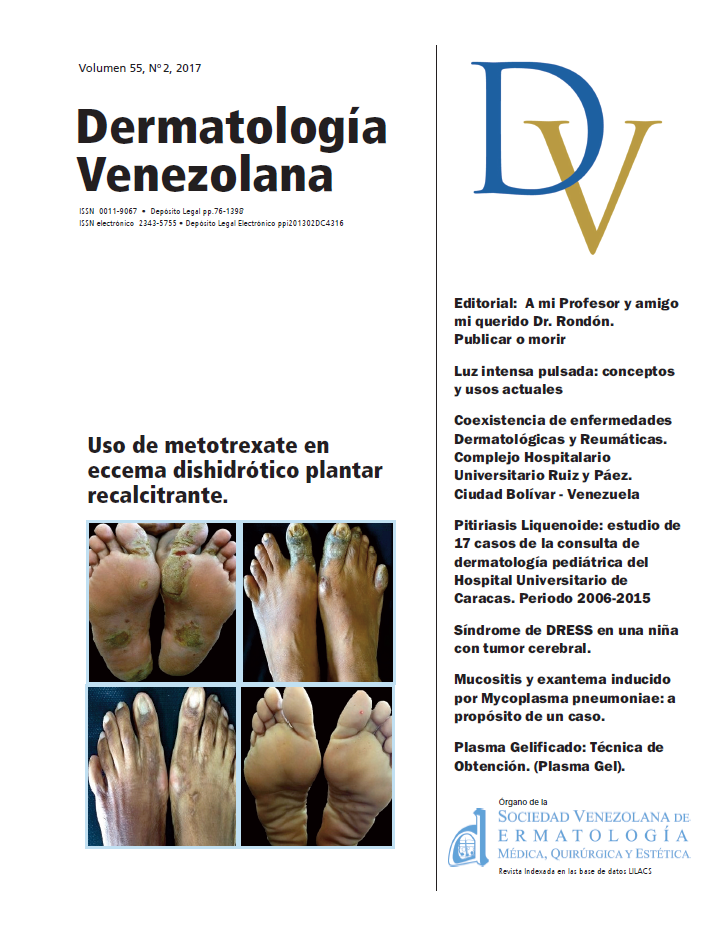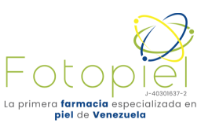Luz intensa pulsada: conceptos y usos actuales.
Palabras clave:
Luz Intensa Pulsada, IPL, fotorejuvenecimiento, fotodepilación, Terapia Fotodinámica, TFDResumen
Los equipos de Luz Intensa Pulsada (IPL por sus siglas en inglés) representan en la actualidad una herramienta esencial en el arsenal terapéutico del dermatólogo. Las características físicas de la luz que emiten permiten su aplicación para el tratamiento efectivo no solo de alteraciones estéticas sino de diversas patologías frecuentes en la consulta dermatológica.
Los usos terapéuticos más frecuentes de esta tecnología incluyen el tratamiento de lesiones vasculares, lesiones pigmentadas, fotodepilación, rosácea, acné, fotoenvejecimiento, cicatrices, estrías; también se utiliza como fuente de luz en tratamientos con terapia fotodinámica (TFD). Más aún, existen algunos reportes de su uso en poroqueratosis, quistes pilonidales y queratosis seborreicas, entre otros. En esta revisión conoceremos las características físicas de la luz emitida por estos equipos, sus efectos en la piel, los principios básicos de su uso, las patologías en las que puede utilizarse, los protocolos generales de tratamiento, y se darán recomendaciones actuales para el uso óptimo y seguro de esta tecnología con base en las publicaciones actuales y en la experiencia de la autora.
Summary
Intense light pulsed: concepts and current uses
Nowadays, Intense Pulsed Light (IPL) devices represent an essential therapeutic tool for dermatologists. The physical properties of this light allow its use not just for esthetic purposes, but also for an effective treatment of several dermatological conditions. Clinical uses of this technology include treatment of vascular lesions, pigmented lesions, photodepilation, rosacea, acne, photoaging, scars, striae. Also, it is used as light source in photodynamic therapy, as well as in other pathologies like porokeratosis, pilonidal cysts, and seborrheic keratosis, and others. This review will show the physical characteristics of the light emitted by these devices, the effects on the skin, the fundamentals of its use, indications, general protocols, and will provide recommendations for the optimal and safe use of this technology based on updated scientific publications, and the autor’s experience.
Key words: Intense Pulsed Light; IPL; photorejuvenation; photodepilation; photodynamic.
therapy
Referencias
Goldman MP. Laser Treatment of Cutaneous Vascular Lesions. Cutaneous and Cosmetic Laser Surgery. Mosby Elsevier; 2006. p. 31–91.
Loyo Z NH, Del Rio Gil R. Luz Pulsada Intensa en Dermatología. In: Rondon Lugo A, editor. Dermatología Iberolatinoamericana Online. 2014.Disponible en: http://201.216.215.169/cilad.org/archivos/Rondon/Rondon2009/IPL.pdf (accesado 19 de octubre 2016).
Bonet J. Lasers and laser-like devices: Part one. Australas J Dermatol. 2013;54(January):173–83.
Li D, Lin S-B, Cheng B. Intense Pulsed Light: From the Past to the Future. Photomed Laser Surg. 2016;34(10):435–47.
Adamic M, Pavlovic MD, Troilius Rubin A, et al. Guidelines of care for vascular lasers and intense pulse light sources from the European Society for Laser Dermatology. J Eur Acad Dermatology Venereol. 2015;29(9):1661–78.
Alexis AF. Lasers and light-based therapies in ethnic skin: Treatment options and recommendations for Fitzpatrick skin types 5 and 6. Br J Dermatol. 2013;169(SUPPL. 3):91–7.
Angermeier MC. Treatment of facial vascular lesions with intense pulsed light. J Cutan Laser Ther. 1999;1(2):95–100.
Wang B, Wu Y, Zhu X, et al. Treatment of neck port-wine stain with intense pulsed light in Chinese population. J Cosmet Laser Ther. 2013;15(2):85–90.
Dong X, Yu Q, Ding J, et al. Treatment of facial port-wine stains with a new intense pulsed light source in Chinese patients. J Cosmet Laser Ther. 2010;12(4):183–7.
Goldman MP. Optimal management of facial telangiectasia. Am J Clin Dermatol. 2004;5(6):423–34.
Tsunoda K, Takahashi K, Ogino N, et al. Treatment of facial telangiectasia with a small spot of intense pulsed light: A case series of three patients. J Dermatol. 2014;41(7):638–41.
Clementoni MT, Gilardino P, Muti GF, et al. Intense pulsed light treatment of 1,000 consecutive patients with facial vascular marks. Aesthetic Plast Surg. 2006;30(2):226–32.
Husain Z, Alster TS. The role of lasers and intense pulsed light technology in dermatology. Clin Cosmet Investig Dermatol. 2016;9:29–40.
Liu J, Liu J, Ren Y, et al. Comparative efficacy of intense pulsed light for different erythema associated with rosacea. J Cosmet Laser Ther. 2014;16(6):324–7.
Weinkle AP, Doktor V, Emer J. Update on the management of rosacea. Clin Cosmet Investig Dermatol. 2015;8:159–77.
Papageorgiou P, Clayton W, Norwood S, et al. Treatment of rosacea with intense pulsed light: Significant improvement and long-lasting results. Br J Dermatol. 2008;159(3):628–32.
Taub AF, Devita EC. Successful treatment of erythematotelangiectatic rosacea with pulsed light and radiofrequency. J Clin Aesthet Dermatol. 2008;1(1):37–40.
DiBernardo BE, Pozner JN. Intense Pulsed Light Therapy for Skin Rejuvenation. Clin Plast Surg. Elsevier Inc; 2016;43(3):535–40.
R. E, C. A, G. T, et al. Pigmentation: Selective photothermolysis or non-specific skin necrosis using different intense pulsed light systems? J Cosmet Laser Ther. 2013;15(3):133–42.
Thaysen-Petersen D, Erlendsson AM, Nash JF, et al. Side effects from intense pulsed light: Importance of skin pigmentation, fluence level and ultraviolet radiation-A randomized controlled trial. Lasers Surg Med. 2016;96(July 2016):88–96.
Babilas P, Schreml S, Szeimies RM, et al. Intense pulsed light (IPL): A review. Lasers Surg Med. 2010;42(2):93–104.
Moreno Arias G a, Ferrando J. Intense pulsed light for melanocytic lesions. Dermatol Surg. 2001;27(4):397–400.
Zoccali G, Piccolo D, Allegra P, et al. Melasma treated with intense pulsed light. Aesthetic Plast Surg. 2010;34(4):486–93.
Lee JH, Chung JY, Choi M, et al. Pulse in pulse intense pulsed light for melasma treatment: A pilot study. Dermatologic Surg. 2014;40(2):162–8.
Weiss RA, Weiss MA. Devices for Nonablative Photorejuvenation. Cutaneous and Cosmetic Laser Surgery. 2006. p. 249–61.
Goldman MP, Weiss R a, Weiss M a. Intense pulsed light as a nonablative approach to photoaging. Dermatol Surg. 2005;31(9 Pt 2):1179–1187; discussion 1187.
Munavalli GS, Weiss RA, Halder RM. Photoaging and nonablative photorejuvenation in ethnic skin. Dermatol Surg. 2005;31(9 Pt 2):1250–60; discussion 1261.
Weiss RA, Weiss MA, Beasley KL. Rejuvenation of photoaged skin: 5 Years results with intense pulsed light of the face, neck, and chest. Dermatologic Surg. 2002;28(12):1115–9.
Cao Y, Huo R, Feng Y, et al. Effects of intense pulsed light on the biological properties and ultrastructure of skin dermal fibroblasts: potential roles in photoaging. Photomed Laser Surg. 2011;29(5):327–32.
Sasaya H, Kawada A, Wada T, et al. Clinical effectiveness of intense pulsed light therapy for solar lentigines of the hands. Dermatol Ther. 2011;24(6):584–6.
Tanaka Y, Tsunemi Y, Kawashima M. Objective assessment of intensive targeted treatment for solar lentigines using intense pulsed light with wavelengths between 500 and 635 nm. Lasers Surg Med. 2016;48(1):30–5.
Holzer G, Nahavandi H, Neumann R, et al. Photoepilation with variable pulsed light in non-facial body areas: Evaluation of efficacy and safety: ORIGINAL ARTICLE. J Eur Acad Dermatology Venereol. 2010;24(5):518–23.
Larouche D, Kim DH, Ratté G, et al. Effect of intense pulsed light treatment on human skin in vitro: analysis of immediate effects on dermal papillae and hair follicle stem cells. Br J Dermatol. 2013;169(4):859–68.
Zandi S, Lui H. Long-Term Removal of Unwanted Hair Using Light. Dermatol Clin. Elsevier Inc; 2013;31(1):179–91.
Klein A, Steinert S, Baeumler W, et al. Photoepilation with a diode laser vs. intense pulsed light: A randomized, intrapatient left-to-right trial. Br J Dermatol. 2013;168(6):1287–93.
Kim BJ, Kim MH, Oh JK, et al. Objective evaluation of photoepilation by phototrichogram. J Dermatol. 2010;37(12):1019–24.
Vejjabhinanta V, Nouri K, Singh A, et al. Laser for hair removal. Lasers Dermatology Med. 2011;24:91–101.
Nahavandi H, Neumann R, Holzer G, et al. Evaluation of safety and efficacy of variable pulsed light in the treatment of unwanted hair in 77 volunteers. J Eur Acad Dermatology Venereol. 2008;22(3):311–5.
Marmur ES, Phelps R, Goldberg DJ. Ultrastructural changes seen after ALA-IPL photorejuvenation: a pilot study. J Cosmet Laser Ther. 2005;7(1):21–4.
Babilas P, Knobler R, Hummel S, et al. Variable pulsed light is less painful than light-emitting diodes for topical photodynamic therapy of actinic keratosis: A prospective randomized controlled trial. Br J Dermatol. 2007;157(1):111–7.
Hasegawa T, Suga Y, Mizuno Y, et al. Efficacy of photodynamic therapy with topical 5-aminolevulinic acid using intense pulsed light for Bowen’s disease. J Dermatol. 2010;37(7):623–8.
Barbaric J, Abbott R, Posadzki P, et al. Light therapies for acne. Cochrane Database Syst Rev. 2016;2016(9).
Taylor Marisa RPR& GM. Intense pulsed light may improve inflammatory acne through TNF-α down-regulation. J Cosmet Laser Ther. 2014;16(October 2013):96–103.
Barakat MT, Moftah NH, El Khayyat MAM, et al. Significant reduction of inflammation and sebaceous glands size in acne vulgaris lesions after intense pulsed light treatment. Dermatol Ther. 2017;30(1):e12418.
Gold MH. Acne and PDT: New techniques with lasers and light sources. Lasers Med Sci. 2007;22(2):67–72.
Momen S, Al-Niaimi F. Acne vulgaris and light-based therapies. J Cosmet Laser Ther. 2014;(November):1–7.
Ianosi S, Neagoe D, Calbureanu M, et al. Investigator-blind, placebo-controlled, randomized comparative study on combined vacuum and intense pulsed light versus intense pulsed light devices in both comedonal and papulopustular acne. J Cosmet Laser Ther. 2013;15(5):248–54.
Piccolo D, Di Marcantonio D, Crisman G, et al. Unconventional use of intense pulsed light. Biomed Res Int. 2014;2014:618206.
Al-Dhalimi MA, Abo Nasyria AA. A comparative study of the effectiveness of intense pulsed light wavelengths (650 nm vs 590 nm) in the treatment of striae distensae. J Cosmet Laser Ther. 2013;15(3):120–5.
Fioramonti P, Fino P, Ponzo I, et al. Intense pulsed light in the treatment of telangiectasias: Case report of Behçet’s disease with superficial vascular involvement. Http://DxDoiOrg/103109/147641722013854634. 2013;1990(September 2013):124–8.
Comstedt LR, Svensson A, Troilius A. Improvement of microstomia in scleroderma after intense pulsed light: A case series of four patients. J Cosmet Laser Ther. 2012;14(2):102–6.
Murray AK, Moore TL, Richards H, et al. Pilot study of intense pulsed light for the treatment of systemic sclerosis-related telangiectases. Br J Dermatol. 2012;167(3):563–9.
Descargas
Publicado
Número
Sección
Licencia
Publicado por la Sociedad Venezolana de Dermatología Médica, Quirúrgica y Estética







